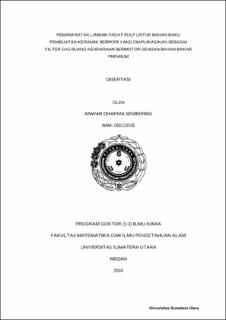Pemanfaatan Limbah Padat Pulp untuk Bahan Baku Pembuatan Keramik Berpori yang Diaplikasikan sebagai Filter Gas Buang Kendaraan Bermotor dengan Bahan Bakar Premium

Date
2010Author
Sembiring, Anwar Dharma
Advisor(s)
Sembiring, Seri Bima
Ginting, Masno
Marlianto, Eddy
Metadata
Show full item recordAbstract
Recently, development and research of technolology based on the phorous
ceramic materials have been greatly improved. One of them fabrication of
phorous ceramics that are used as filter of emissed gasses from engines. Based on
the above purpose, the characterization and fabrication of of phorous ceramics
have been performed based in solid pulp waste that consist of grit, dreg and bio
sludge. Then those three substances are mixed with a kaolin. The variations of
mass percentage of the kaolin an the solid pulp waste and kaolin are as following
100:0; 90:10; 80:20; 70:30; 60:40; 50:50%. Each of the sample was mixed with
adequate plastician water. After getting homogenous sample, the sample was
poured into a cylindrical dough with a 20 cm of height, 1,5 inch of outer diameter
and 0,65 inch of inner diameter, then all the samples were dried for 4 days. All the
samples were burned in a furnace at temperature of 1100o C and kept at the
temperaturefor 2 hours, then cooled down for 12 hours. After that all the samples
were tested physically and mechanically. Based on the experiment, it was found
physically that decrease mass as 17,77 – 32,10%; decrease burning as 1,97 – 4,07
gram/cm3; phorousity as 27,96 – 54,27%; and density of 1,14 – 1,20 gram/cm3.
Moreover from the mechanical tese, it was foud that the impact srength of
1,49x10-2 – 4,05x10-2 MPa and te hardness of 87 – 127 MPa. Before gas emissed
testing was performed, all the samples are analyzed to calculate the chemical
composition of the ceramics using X-Ray difraction method. From the
experiment, it was seen the dominant phase were hydrooxide alumina silicate
Al2(Si2O5)(OH)4, Alumina Al2O3 and oxide silica (SiO2). In order to obtain the
influence of the ceramics filter, the emissed gas was performed using a Gas
Analyzer with and without the ohorous ceramics. From the test, it was shown that
using of ceramic filter reduces a combustion gas significantly. The reduces of the
emissed gas were obtained as following 36,21 – 97,14% of CO; 36,47 – 87,87%
of HC; 25,64 – 95,97% of CO2 and the increase of O2 from 400,72 – 1264,03%.
The optimum concentration was chosen as 70% solid waste pulp and 30% of
kaolin, that was classified as a best phorous ceramics for combusted gas filter. The
gas emission without the ceramic filter at a starting point (0 km) was found to be
0,05 % of CO; 12,88% of CO2 ; 207 ppm of HC; and 3,08% of O2. While the gas
emission with the ceramic filter after running 6099 km distance was found to be
0,398% of CO; 11,42% of CO2; 123 ppm HC, and 391% of O2. Based on the gas
emission test, the ceramics filter are most probably used for more than 6099 km in
fistance, then the similar test is needed to performed. Perkembangan teknologi di bidang material khususnya material keramik berpori
akhir-akhir ini telah banyak digunakan sebagai filter gas buang. Sehubungan
dengan tujuan tersebut, telah dilakukan pembuatan keramik berpori berbasis
limbah padat pulp yang terdiri dari gugusan grit, dreg dan biosludge.
Perbandingan ketiga bahan ini divariasikan dan selanjutnya dicampur dengan
bahan baku keramik yaitu kaolin. Pencampuran limbah padat pulp dan kaolin
dilakukan beberapa variasi berdasarkan % massa bahan, antara lain: limbah padat
pulp berbanding kaolin adalah 100 : 0 ; 90 : 10; 80 : 20; 70: 30; 60 : 40; 50 : 50%.
Masing-masing campuran ini diaduk dengan menambah air plastisan secukupnya
dengan mixer. Setelah homogen dituang ke dalam cetakan dalam bentuk silinder
dengan ukuran tinggi 20 cm, diameter luar 1,5 inci dan diameter dalam 0,63 inci,
lalu dikeringkan selama 4 hari. Pembakaran dilakukan dengan furnace pada
temperatur 1100oC yang ditahan selama 2 jam, kemudian didinginkan selama 12
jam. Terhadap sampel-sampel uji dilakukan pengujian secara fisis maupun
mekanik. Dari pengujian fisis diperoleh susut massa 17,37 – 32,10%; susut bakar
1,97 – 4,07%; porositas 27,96 – 54,27%; dan densitas 1,14 – 1,20 gr/cm3.
Sedangkan pengujian mekanik diperoleh : kuat tekan 0,98-69,58 MPa; kuat impak
1,49 x 10-2 – 4,05 x 10-2 MPa, dan kekerasan 87-127 Mpa. Sebelum dlakukan
pengujian emisi gas, juga dilakukan analisis XRD untuk mengetahui komposisi
senyawa kimia, dan diperoleh dari yang paling dominan yaitu : Alumina Silicate,
Hidroxide, Al2(Si2O5) (OH)4, Alumina Al2O3 dan Silikon Okside SiO2. Untuk
mengetahui pengaruh penggunaan filter, maka dilakukan pengujian emisi gas
buang dengan peralatan “ Analyzer Gas” , ternyata penggunaan filter memberikan
pengaruh yang sangat besar untuk mengurangi pencemaran udara. Pengurangan
tersebut mencapai 36,21 – 97,14% CO; 36,47-87,87% HC; 25,64 – 95,97% CO2.
Dan pertambahan O2 dari 400,72 – 1264,03%. Untuk pengujian maksimal pada
pemakaian filter, terlebih dahulu dipilih campuran 70% limbah padat pulp dan
30% kaolin, dimana campuran ini merupakan komposisi keramik berpori yang
terbaik, jika difungsikan sebagai filter emisi gas buang dan selanjutnya diukur
emisi gas tanpa filter dan pakai filter. Emisi gas tanpa filter pada 0 km diperoleh
konsentrasinya 0,505% CO; 12,88% CO2; 07 ppm HC dan 3,08% O2, Sedangkan
dengan memakai filter sampai 6099 km ternyata emisinya mengalami perubahan
yaitu 0,398% CO; 11,42% CO2, 123 ppm HC dan 3,91% O2. Dengan demikian
filter keramik berpori ini masih layak digunakan untuk jangkauan lintas diatas
6099 kilometer. Hal ini dapat dibandingkan dengan konsentrasi gas, ketika filter
gas buang belum dipergunakan.
Collections
- Doctoral Dissertations [102]
